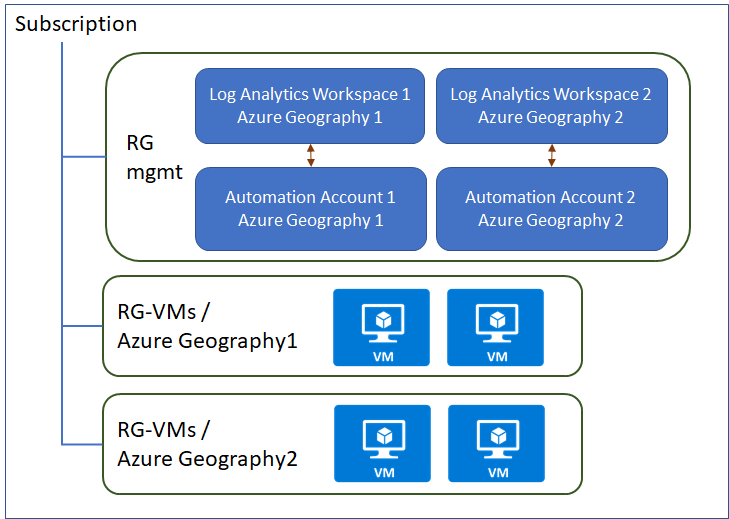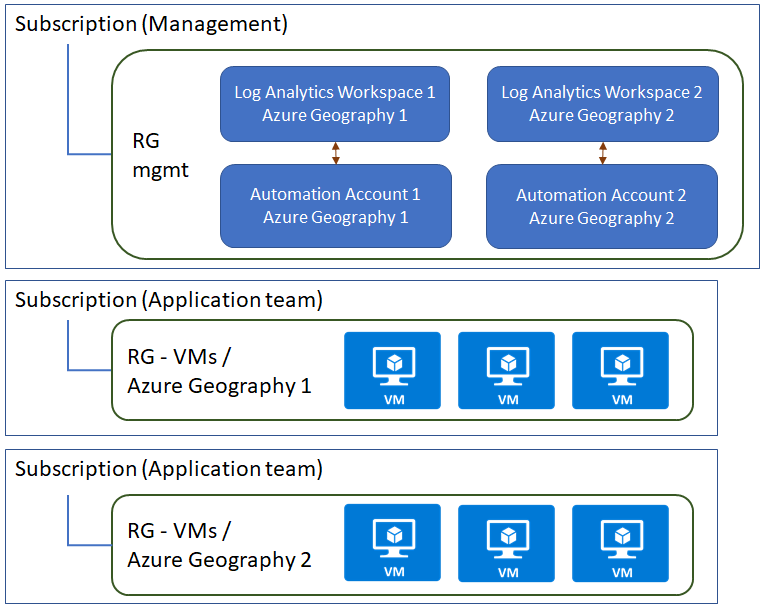Phase 1: Prerequisite planning for Azure server management services
In this phase, you'll become familiar with the Azure server management suite of services, and plan how to deploy the resources needed to implement these management solutions.
Understand the tools and services
Review Azure server management tools and services for a detailed overview of:
- The management areas that are involved in ongoing Azure operations.
- The Azure services and tools that help support you in these areas.
You'll use several of these services together to meet your management requirements. These tools are referenced often throughout this guidance.
The following sections discuss the planning and preparation required to use these tools and services.
Log Analytics workspace and Automation account planning
Many of the services you'll use to onboard Azure management services require a Log Analytics workspace and a linked Azure Automation account.
A Log Analytics workspace is a unique environment for storing Azure Monitor log data. Each workspace has its own data repository and configuration. Data sources and solutions are configured to store their data in particular workspaces. Azure monitoring solutions require all servers to be connected to a workspace, so that their log data can be stored and accessed.
Some of the management services require an Azure Automation account. You use this account, and the capabilities of Azure Automation, to integrate Azure services and other public systems to deploy, configure, and manage your server management processes.
The following Azure server management services require a linked Log Analytics workspace and Automation account:
The second phase of this guidance focuses on deploying services and automation scripts. It shows you how to create a Log Analytics workspace and an Automation account. This guidance also shows you how to use Azure Policy to ensure that new virtual machines are connected to the correct workspace.
The examples in this guidance assume a deployment that doesn't already have servers deployed to the cloud. To learn more about the principles and considerations involved in planning your workspaces, see Manage log data and workspaces in Azure Monitor.
Planning considerations
When preparing the workspaces and accounts that you need for onboarding management services, consider the following issues:
- Azure geographies and regulatory compliance: Azure regions are organized into geographies. An Azure geography ensures that data residency, sovereignty, compliance, and resiliency requirements are honored within geographical boundaries. If your workloads are subject to data-sovereignty or other compliance requirements, workspace and Automation accounts must be deployed to regions within the same Azure geography as the workload resources they support.
- Number of workspaces: As a guiding principle, create the minimum number of workspaces required per Azure geography. We recommend at least one workspace for each Azure geography where your compute or storage resources are located. This initial alignment helps avoid future regulatory issues when you migrate data to different geographies.
- Data retention and capping: You may also need to take data retention policies or data capping requirements into consideration when creating workspaces or Automation accounts. For more information about these principles, and for additional considerations when planning your workspaces, see Manage log data and workspaces in Azure Monitor.
- Region mapping: Linking a Log Analytics workspace and an Azure Automation account is supported only between certain Azure regions. For example, if the Log Analytics workspace is hosted in the
East USregion, the linked Automation account must be created in theEast US 2region to be used with management services. If you have an Automation account that was created in another region, it can't link to a workspace inEast US. The choice of deployment region can significantly affect Azure geography requirements. Consult the region mapping table to decide which region should host your workspaces and Automation accounts. - Workspace multihoming: The Azure Log Analytics agent supports multihoming in some scenarios, but the agent faces several limitations and challenges when running in this configuration. Unless Microsoft has recommended it for your specific scenario, don't configure multihoming on the Log Analytics agent.
Resource placement examples
There are several different models for choosing the subscription in which you place the Log Analytics workspace and Automation account. In short, place the workspace and Automation accounts in a subscription owned by the team that's responsible for implementing the Update Management solution and the Change Tracking and Inventory service.
The following are examples of some ways to deploy workspaces and Automation accounts.
Placement by geography
Small and midsize environments have a single subscription and several hundred resources that span multiple Azure geographies. For these environments, create one Log Analytics workspace and one Azure Automation account in each geography.
You can create a workspace and an Azure Automation account, as one pair, in each resource group. Then, deploy the pair in the corresponding geography to the virtual machines.
Alternatively, if your data-compliance policies don't dictate that resources reside in specific regions, you can create one pair to manage all the virtual machines. We also recommend that you place the workspace and Automation account pairs in separate resource groups to provide more granular Azure role-based access control (Azure RBAC).
The example in the following diagram has one subscription with two resource groups, each located in a different geography:

Placement in a management subscription
Larger environments span multiple subscriptions and have a central IT team that owns monitoring and compliance. For these environments, create pairs of workspaces and Automation accounts in an IT management subscription. In this model, virtual-machine resources in a geography store their data in the corresponding geography workspace in the IT management subscription. If application teams need to run automation tasks but don't require linked workspace and Automation accounts, they can create separate Automation accounts in their own application subscriptions.

Decentralized placement
In an alternative model for large environments, the application development team can be responsible for patching and management. In this case, place the workspace and Automation account pairs in the application team subscriptions alongside their other resources.

Create a workspace and Automation account
After you've chosen the best way to place and organize workspace and account pairs, make sure that you've created these resources before starting the onboarding process. The automation examples later in this guidance create a workspace and Automation account pair for you. However, if you want to onboard by using the Azure portal and you don't have an existing workspace and Automation account pair, you'll need to create one.
To create a Log Analytics workspace by using the Azure portal, see Create a workspace. Next, create a matching Automation account for each workspace by following the steps in Create an Azure Automation account.
Next steps
Learn how to onboard your servers to Azure server management services.